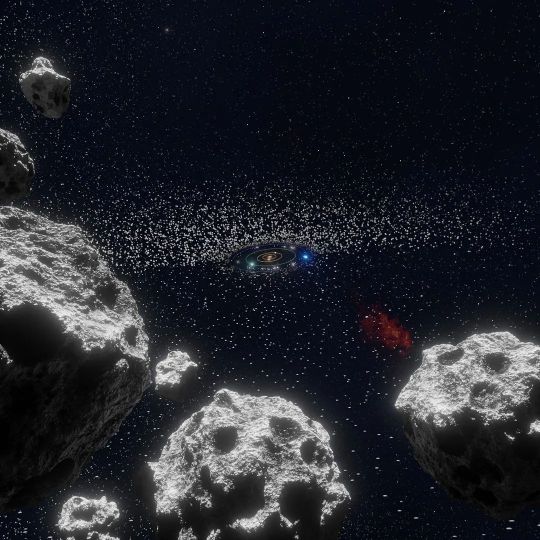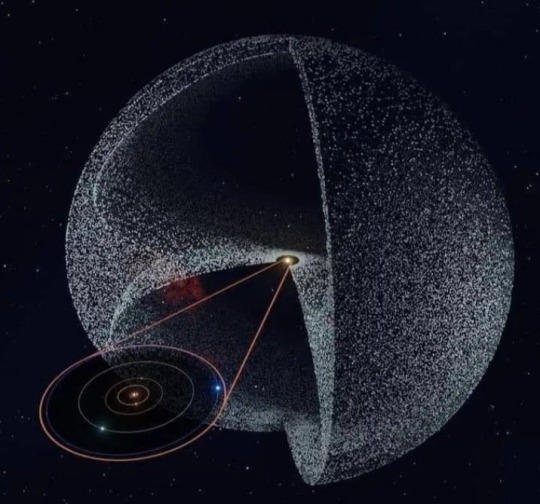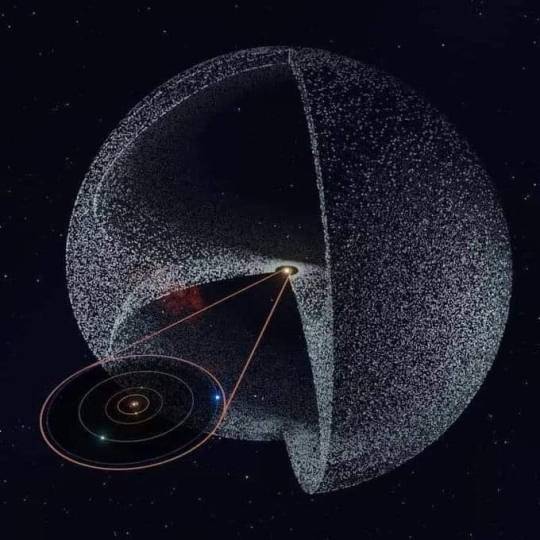#oort cloud
Explore tagged Tumblr posts
Text

Comet C/2023 A3 (Tsuchinshan-ATLAS) hanging over Bieszczady, Poland on October 16, 2024 // Dominik Sito
#astronomy#astrophotography#night sky#solar system#comet#icy body#oort cloud#C/2023 A3 (Tsuchinshan-ATLAS)#comet c/2023 a3#comet tsuchinshan atlas#landscape#beautiful#peaceful#Bieszczady#poland
220 notes
·
View notes
Note
Boom, I’m putting Oort Cloud in control of Sun’s body
Only if mod is ok with it :3
(Oh yeah definitely, go ahead)
Oort Cloud opened his eyes. He was expecting to wake up in the cozy mind of Sundew. NOT in Sundew's body. He looked around, confused. Then, he contacted the only person he knew to call: @crazed-moondrop
(Btw idc if it's Silver or Crescent, Oort Cloud will be struggling regardless)
#solars sun#sunfessions#not a confession#lore rp#sun and moon show#the celestial shitheads#do not ship them#oort cloud
26 notes
·
View notes
Photo


“ Imagine a massive celestial bubble made of ice and dust surrounding our Solar System. That’s the Oort cloud ❄️🌌 🚀 The Oort Cloud lies at the very edges of the Solar system. It’s so far away that it can’t be seen directly and remains unexplored by spacecraft. 🌠 Long-period comets, taking centuries to orbit the Sun, provide evidence for the existence of the Oort Cloud. Scientists believe this vast region is the birthplace of these cosmic travelers. ☄️ Apart from long-period comets, the Oort cloud may feature asteroids and dwarf planets. “
// astro.voyagers
#space#planets#earth#moon#mercury#Venus#Mars#Jupiter#Saturn#Neptune#Uranus#pluto#SolarSystem#galaxy#Galaxies#MilkyWay#universe#oort cloud#aesthetics#wanderlust#explore#follow#discover
384 notes
·
View notes
Text

The Oort Cloud: where the solar system ends. ⚫
—
The Oort cloud is a theoretical cloud of comets and small icy objects located at the outermost edge of the solar system.
They create a spherical shell-like shape that orbits the Sun.
The Oort cloud is estimated to extend a vast distance of up to 3 light-years from the Sun.
14 notes
·
View notes
Photo


galaxies : The Oort Cloud lies at the very edges of the Solar system. Even the farthest [human-made objects] which are still working, like Voyager 1, Voyager 2 and New Horizons [have not gone] beyond the cloud. Long-period comets, taking centuries to orbit the Sun, provide evidence for the existence of the Oort Cloud. Scientists believe this vast region is the birthplace of these cosmic [travellers].
19 notes
·
View notes
Text


The Oort Cloud
The Oort cloud (sometimes called the Öpik–Oort cloud) is theorized to be a vast cloud of icy planetesimals surrounding the Sun at distances ranging from 2,000 to 200,000 AU (0.03 to 3.2 light-years. The concept of such a cloud was proposed in 1950 by the Dutch astronomer Jan Oort, in whose honor the idea was named. Oort proposed that the bodies in this cloud replenish and keep constant the number of long-period comets entering the inner Solar System—where they are eventually consumed and destroyed during close approaches to the Sun. The cloud is thought to comprise two regions: a disc-shaped inner Oort cloud aligned with the solar ecliptic (also called its Hills cloud) and a spherical outer Oort cloud enclosing the entire solar system. Both regions lie well beyond the heliosphere and are in interstellar space. The Kuiper belt, the scattered disc and the detached objects—three other reservoirs of trans-Neptunian objects—are more than a thousand times closer to the Sun than the innermost portion of the Oort cloud (as shown in a logarithmic graphic within this article)...
Read more: Oort cloud - Wikipedia
67 notes
·
View notes
Note

One Radiant Thing (ORT) (Lostbelt)
He’s, quite literally, the strongest, being the Ultimate One of the Oort Cloud.
context: Kyubey is a magical being that can avoid damage through teleportation, and can seemingly "respawn" an infinite number of times
3 notes
·
View notes
Text

australianspaceagency
Don't miss what could be 2025's brightest comet, Atlas C/2024 G. ☄️
It will reach perihelion - the point of its orbit closest to the sun - tonight. It will also be at its closest point to Earth, and unlike other comets this year, is likely to be visible to the naked eye. So if you are in the southern hemisphere, it will be to the west just after sunset tonight.
4 notes
·
View notes
Text

#066: Oortsider
These colossal organisms have adapted to live within asteroid belts and Oort clouds. Living in outer space without gravity, their bodies have no real up or down, and can maneuver through the icy rocks regardless of orientation! It's thought they first evolved in protoplanetary disks, and as solar systems formed, they moved to the outer clouds of space debris. A lifeform that can exist and thrive before life-sustaining planets are even formed! In the vacuum of space, they can only communicate via flashes of light, half of each eye can produce light of different colors, while the other half receives the light!
Based on a speculative biology concept I've had for a while! A true alien species that lives in the Oort cloud!
#creature design#species design#alien design#specbio#oort cloud#speculative biology#space#sooo happy to finally draw them!
18 notes
·
View notes
Text

Comet C/2023 A3 (Tsuchinshan-ATLAS) on October 13, 2024 // S.Nagahiro
Go outside and see it now while you can! It won't be back for another ~235,000 years!
#astronomy#astrophotography#solar system#comet#icy body#oort cloud#comet tsuchinshan atlas#C/2023 A3#comet c/2023 a3
157 notes
·
View notes
Text
Dormant Ice Kingdom
youtube
Friends, this is a track from my new album, «Oort Cloud», which was released a few days ago and is dedicated to the farthest reaches of the Solar System. It is so far from us — tens and hundreds of thousands of astronomical units — that it may seem that these spaces do not affect us in any way. But it is from these cold lands that new comets regularly fly to us. Why this suddenly happens is described in the booklet that comes with the album «Oort Cloud», which you can purchase and download here:
It may seem that the expanses of the Oort Cloud are full of icy icebergs. There really are a lot of them there, if you count them one by one — billions of icy celestial bodies ranging in size from a few meters to probably thousands of kilometers in diameter. But the Cloud itself, which envelops the entire Solar System in such a snow blanket, is so large (its radius is estimated at 100,000 astronomical units, where 1 astronomical unit is the average distance from the Earth to the Sun) that a simple calculation will show us the average distance between the objects inhabiting the cloud. And if we take the number of noticeable-sized bodies (from a kilometer and up) in the Oort Cloud to be equal to 1 billion, it turns out that they drift at a respectful distance from each other — on average about 100 astronomical units. It is unlikely that they even feel the influence of their neighbors in the Cloud. If they collide, then only a few times during the entire existence of the Solar System, and even then — by very great "luck." The calm and measured life of these celestial bodies could continue forever if not for the stars that sometimes pass close to the Sun - literally through the Oort Cloud.
But we will have a separate story about this and special music dedicated to such events.
You can purchase my new album «Oort Cloud» from the «Parade of Planets» series using this link:
Happy New Year, Friends!
4 notes
·
View notes
Note
Plop
(Puts crescent in suns head and puts Oort Cloud in @crazed-moondrop ‘s head)
Have fun :P!
Oort Cloud woke up, feeling dazed. Where was he?...
He shivered before coughing a bit.
13 notes
·
View notes
Text

oortcloudcomet on bluesky 😛
2 notes
·
View notes
Text

Imagine a massive celestial bubble made of ice and dust surrounding our Solar System — that’s the Oort Cloud and this is its scale.
The Oort Cloud lies at the very edges of the solar system.
Even the farthest ones, which are still working like Voyager 1, Voyager 2 and New Horizons, didn't go beyond the cloud.
Long-period comets, taking centuries to orbit the Sun, provide evidence for the existence of the Oort Cloud.
Scientists believe this vast region is the birthplace of these cosmic travelers.
15 notes
·
View notes
Text
Is the Oort cloud gravitationally bound to the Sun? What I mean is, is it part of the solar system with the Sun at it's center, or is it just a big ball of gas and debris that the Sun happens to be in? If the former, does that mean other stars have their own Oort clouds? If the latter, are any of our stellar neighbors in the cloud with us?
7 notes
·
View notes
Text

Imagine a massive celestial bubble made of ice and dust surrounding our Solar System. That’s the Oort cloud and this is its scale.
The Oort Cloud lies at the very edges of the Solar system. Even the farthest ones which are still working, like Voyager 1, Voyager 2 and New Horizons didn't go beyond the cloud. Long period comets, taking centuries to orbit the Sun, provide evidence for the existence of the Oort Cloud. Scientists believe this vast region is the birthplace of these cosmic travelers...✨
#earth#planet earth#star wars#space science#spacecraft#earth from space#study space#deep space nine#little space#liminal spaces#space exploration#space explorers#space advances#deep space exploration#oort cloud#outer space#solar system#solar eclipse#solar#sunset#astro observations#astro community#astro notes#science acumen#science and technology#science
5 notes
·
View notes